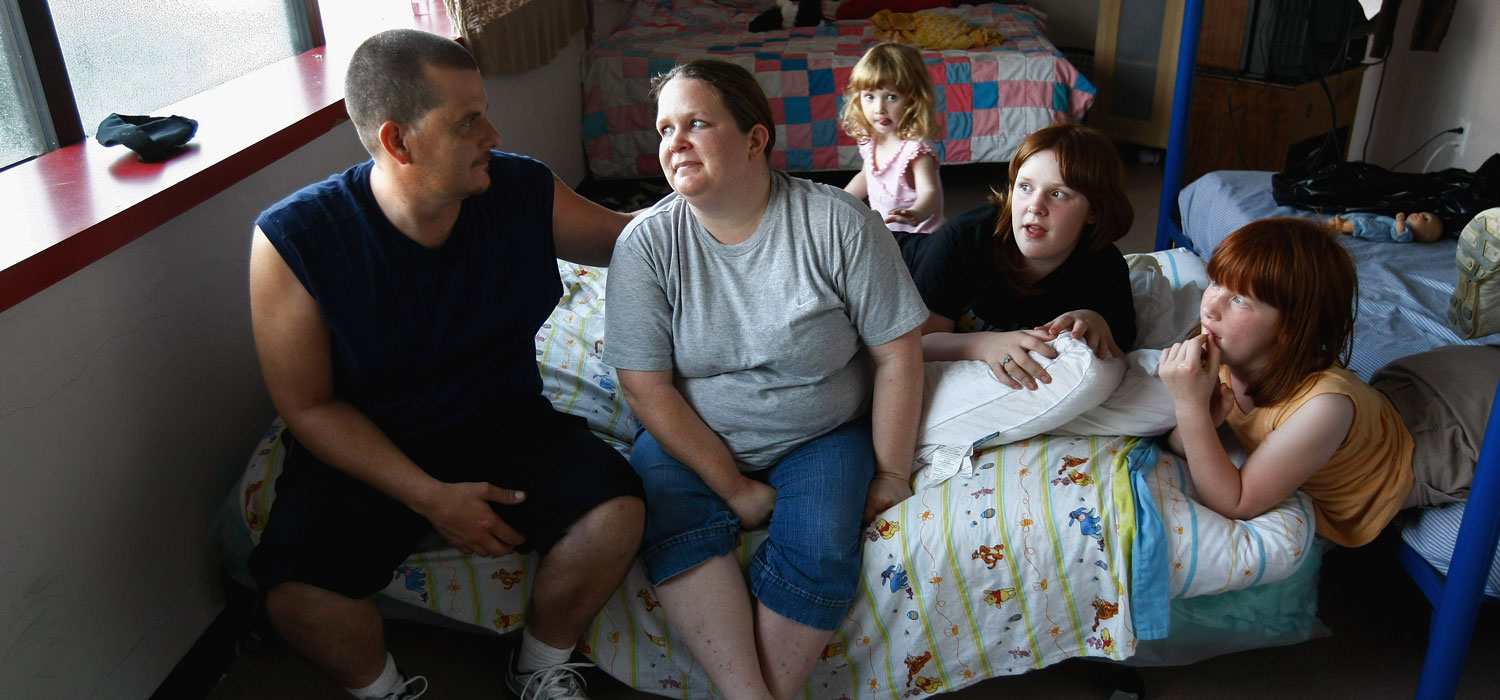
<p>Brian and Julie Morris sit with their three daughters in their room at the Family Gateway homeless shelter on June 18, 2009 in Dallas, Texas. Morris was laid off from his construction job in April and the family was evicted from their home in Hurst, Texas, when they could no longer make their rent payments. Photo by John Moore/Getty Images.</p>
America’s rental housing crisis is getting worse. A new report from the US Department of Housing and Urban Development (HUD) found that 8.3 million very low-income households paid more than half their monthly income on rent or lived in severely substandard housing in 2015.
The number of these “worst case housing needs” rose 66 percent since 2001 and nearly 41 percent since 2008. But the report’s release comes as the Trump administration has proposed cutting nearly 15 percent from HUD’s budget and 68 percent from the Public Housing Capital Fund.
In the following conversation with Susan Popkin, a senior fellow in the Urban Institute’s Metropolitan Housing and Communities Policy Center, the findings of this report come as no surprise.
Limited rental inventory, growing demand, and a lack of sufficient federal funding have been ongoing problems. If nothing changes, or if the administration makes its proposed cuts, the number of worst-case households will continue to climb, Popkin said.
What are your key take-aways from the HUD report?
We’re in the worst affordable housing crisis in memory, and HUD is unprepared for it. This is the key issue for the new HUD secretary: Only one in four people eligible for housing assistance are getting help. Nowhere in the United States can anyone making the minimum wage afford a standard two-bedroom apartment. This new HUD report found that the proportion of people paying over 50 percent of monthly income on rent has risen by 66 percent since 2001 and 41 percent since 2008. So we have a situation that’s getting worse and no plan to address it.
Why has the rental housing crisis continued to get worse?
One reason is that because of the recession, a lot of people moved from being homeowners back into the rental market, and that put pressure on rents. Another reason is that most of the incentives for building housing are in single-family homes and luxury housing. In some cities, we’re going to have a surplus of single-family homes as older folks give them up, and there isn’t enough new multifamily inventory. We’re not constructing apartment buildings at the lower end of the market. There are not a lot of market incentives to build affordable multifamily housing. And there are so many millennials. A lot are moving out of their parents’ homes and getting into the housing market, and they need somewhere to live.
So you have the lack of production, you have prices going up because so many people are in the market, and then you have the squeeze on housing assistance. We already didn’t have enough housing assistance. That was true before Trump got elected, and it was true before Obama got elected. It’s been going on for a long time. The housing authorities have had to make do with less, so they’re issuing fewer vouchers. The situation only got better for a little while right after the recession when we had the stimulus package. That’s the last time there was a big infusion of cash for the Housing Choice Voucher Program.
Another issue is that one of the ways we fund construction of affordable housing is through the Low-Income Housing Tax Credit, but there is tremendous uncertainty in the Low-Income Housing Tax Credit market right now because of the proposed changes to the tax code.
How can we solve this lack of rental inventory?
You’d have to change the market incentives to give developers incentives to build low and moderate private rental market housing. Right now, most incentives are for luxury housing.
The private sector won’t build more unless the incentives change. That means more tax credits and more incentives from the federal government. Right now, developers can make a lot more money building luxury condos in DC and New York and other hot housing markets.
What other tactics could help solve the rental housing crisis?
One suggestion that some advocates are pushing would be eliminating the mortgage interest tax deduction. If you did that, it would fund all of this, even if they just eliminated it for second homes. The United Kingdom does not have the same subsidy, and their homeownership rate is exactly the same as ours. There’s a big argument being made for eliminating the deduction, but that change has a low probability of being enacted.
We could also decide that we’re going to have more housing assistance. The government could stabilize the value of the low-income tax credits so they stop losing value. The government has to make it profitable to build more housing, and at the same time, it needs to provide a serious amount of assistance. There are ways to do that that aren’t deep subsidies and aren’t as costly. They could have a shallower subsidy for people who are working poor. They could create a program that would provide people with emergency assistance so they don’t go homeless if they lose a job for a few months. A lot of policy options have been proposed, but none are under discussion at this point.
The bottom line is there’s not enough affordable housing anywhere in the United States. It’s not an urban problem, it’s a national problem. It’s happening in small cities, in rural areas, everywhere. And it’s going to get worse unless something changes.
Let’s build a future where everyone, everywhere has the opportunity and power to thrive
Urban is more determined than ever to partner with changemakers to unlock opportunities that give people across the country a fair shot at reaching their fullest potential. Invest in Urban to power this type of work.